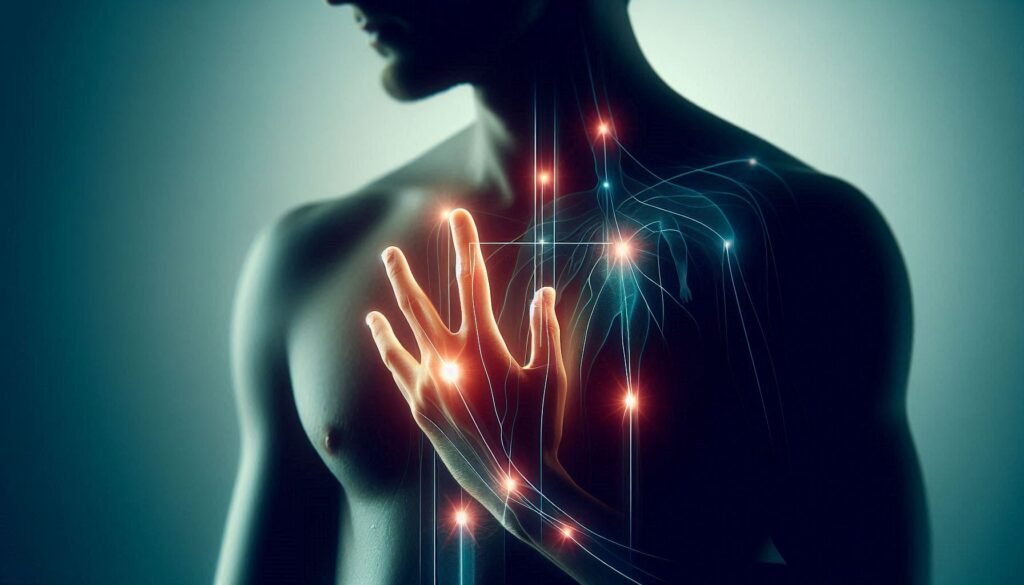Paresthesia is often associated with tingling, numbness, or a “pins and needles” sensation. While these classic signs are well-known, many individuals overlook the silent symptoms that can indicate underlying issues. These subtle changes in bodily functions may not demand immediate attention but could signal something more serious brewing beneath the surface.
Understanding these less obvious signs of paresthesia is crucial for timely intervention and improved health outcomes. By tuning into your body’s whispers rather than waiting for loud alarms to sound, you can take proactive steps toward better management of your condition. Let’s delve into some lesser-known indicators that might be flying under your radar—because recognizing them early could make all the difference in your wellness journey.

Understanding Silent Paresthesia: Beyond the Typical Sensations
Paresthesia is commonly recognized through sensations like tingling or numbness in the extremities. However, this condition encompasses a broader spectrum of silent symptoms that often go unacknowledged. Many people may experience these signs without realizing they are linked to paresthesia.
These subtle manifestations can arise from various factors, including nerve damage, poor circulation, and certain medical conditions. Consequently, individuals might dismiss them as trivial discomforts rather than potential warning signals. This lack of awareness can lead to delayed diagnosis or ineffective management.
Moreover, the emotional impact should not be overlooked. Experiencing unexplained sensations can generate anxiety and stress, further complicating one’s overall health. Understanding that paresthesia extends beyond classic symptoms encourages individuals to pay closer attention to their bodies.
Being informed about these hidden aspects of paresthesia allows for better self-advocacy when discussing symptoms with healthcare providers. Recognizing that there’s more beneath the surface could lead to vital insights into your health status.
Subtle Changes in Sensory Perception: Early Warning Signs
Subtle changes in sensory perception can serve as early warning signs of paresthesia. You may notice that certain sensations feel different or are less intense than before. This could manifest as a reduced ability to feel textures, temperatures, or vibrations.
Some people report a tingling sensation in specific areas without any obvious cause. You might experience numbness or heightened sensitivity in your fingers, toes, or limbs. These alterations can easily be overlooked but signal underlying issues with nerve function.
It’s essential to pay attention to these seemingly minor shifts. They often precede more pronounced symptoms and can indicate problems such as nerve compression or metabolic disorders. Ignoring them may lead to further complications down the line.
Being aware of your body’s signals is crucial for timely intervention. Keeping track of any unusual feelings will help you communicate effectively with healthcare professionals if needed.
Proprioception Issues: The Hidden Impact on Balance and Coordination
Proprioception is the body’s ability to sense its position in space. It plays a crucial role in maintaining balance and coordination. When paresthesia occurs, this sensory perception can be disrupted, leading to unexpected challenges.
Individuals may experience difficulties with spatial awareness. Simple movements like walking or reaching for objects can become daunting tasks. This often results from the brain receiving mixed signals about limb position due to nerve irregularities.
The impact of proprioception issues extends beyond physical activity; it affects daily life quality. Tasks that once felt second nature may now require heightened concentration and effort. Such changes can lead to frustration and anxiety as individuals navigate their environment cautiously.
Moreover, falls become a real concern when proprioceptive feedback diminishes. A lack of awareness regarding body positioning increases the risk of accidents, particularly among older adults or those with existing health conditions. Recognizing these subtle shifts is key in addressing related complications effectively.
Microvascular Changes: Invisible Effects on Skin and Tissues
Paresthesia often signals deeper issues, including microvascular changes that may go unnoticed. These alterations occur in the tiny blood vessels responsible for supplying oxygen and nutrients to skin and tissues. When these vessels function improperly, symptoms can arise without clear visibility.
People experiencing paresthesia might not recognize how compromised blood flow affects their skin health. Reduced circulation can lead to dryness, discoloration, or even increased sensitivity in certain areas. You may dismiss these signs as mere aging or environmental factors when they could be linked to underlying vascular issues.
Additionally, microvascular changes can impair wound healing. Small cuts or abrasions may take longer to recover due to insufficient blood supply. This delay poses a risk for infection and further complications if not addressed promptly.
Understanding the invisible effects of these changes is crucial for maintaining overall well-being. If you notice unusual skin reactions alongside sensations of tingling or numbness, it’s essential to pay attention and seek professional advice.
Cognitive Fog: The Overlooked Mental Aspect of Paresthesia
Cognitive fog is a subtle yet significant symptom of paresthesia that often goes unnoticed. Many people experiencing this condition report difficulties in concentration and mental clarity. This cognitive impairment can be frustrating, especially when tasks require focus.
The brain’s intricate network relies heavily on sensory input for optimal function. When paresthesia disrupts these signals, it may lead to confusion or forgetfulness. Individuals might find themselves struggling with simple decisions or recalling information they once knew effortlessly.
Moreover, the emotional impact should not be overlooked. Anxiety and stress can arise from feeling mentally “off,” further exacerbating symptoms of paresthesia. The combination creates a cycle that affects overall well-being.
Recognizing cognitive fog as part of the broader spectrum of paresthesia is crucial for those affected. Addressing this aspect could improve quality of life and provide better insights into managing the condition effectively.
Autonomic Nervous System Disruptions: Silent Yet Significant
The autonomic nervous system (ANS) plays a crucial role in regulating involuntary bodily functions, including heart rate and digestion. Disruptions within this system can lead to silent yet significant symptoms that often go unnoticed.
Individuals experiencing paresthesia might find their ANS affected, leading to abnormal responses in various body systems. For example, changes in skin temperature or sweating patterns may not be immediately linked to nerve issues but could indicate underlying dysfunction.
These disruptions can also manifest as fluctuations in blood pressure. Such variations can cause feelings of lightheadedness or fatigue without a clear physical explanation, further complicating the recognition of symptoms.
Recognizing these subtle signs is essential for early intervention. The more we understand the intricate workings of our bodies, the better equipped we become at identifying potential problems before they escalate into serious health concerns. Awareness is key when it comes to managing conditions related to the autonomic nervous system and paresthesia.
Muscle Fatigue and Weakness: Gradual Onset Symptoms
Muscle fatigue and weakness can often be subtle indicators of underlying paresthesia. These symptoms may not appear suddenly; instead, they typically develop gradually over time. This slow onset can make it easy to dismiss them as mere tiredness or the result of a long day.
As you go about your daily activities, you might notice that tasks requiring physical strength become increasingly challenging. You may find yourself needing more breaks than usual or feeling unusually drained after light exercise. This gradual decline in muscle function is one aspect that should not be ignored.
Moreover, these sensations can lead to frustration and anxiety, compounding the issue further. It’s essential to pay attention to how your body feels during various activities because persistent fatigue could indicate nerve-related issues linked with paresthesia.
Ignoring these signs could risk worsening your condition over time. Being proactive about recognizing these changes is crucial for maintaining overall health and well-being.
Temperature Regulation Abnormalities: A Subtle Sign
Temperature regulation abnormalities can be a subtle yet significant symptom of paresthesia. Many individuals may not associate fluctuations in temperature with nerve issues. However, these changes often signal underlying neurological problems.
People experiencing silent symptoms of paresthesia might notice their extremities feeling unusually cold or hot. This discomfort arises from the nervous system’s impaired ability to communicate effectively with blood vessels and sweat glands, leading to altered responses to environmental temperatures.
In some cases, this dysregulation can result in excessive sweating or an inability to tolerate heat. These symptoms are frequently overlooked as they don’t fit the typical narrative associated with paresthesia.
Moreover, constant shifts between feeling too warm and too cool can result in increased anxiety and irritability. Recognizing these nuances is essential for understanding how silent symptoms of paresthesia manifest beyond traditional sensations like tingling or numbness.
Delayed Reaction Times: An Often Missed Symptom
Delayed reaction times can be a subtle yet significant symptom of paresthesia. Many people overlook this sign, attributing it to fatigue or distraction. However, these delays often stem from disruptions in nerve signaling caused by conditions affecting sensory pathways.
When your nerves are compromised, the messages sent from peripheral areas to the brain may slow down. This lag can affect everyday activities, such as driving or playing sports. You might find yourself reacting more slowly than usual when faced with quick decisions or unexpected situations.
These delayed responses can lead to misunderstandings about one’s overall health and physical capabilities. Friends and family may notice changes before you do, prompting concerns that could go unaddressed for longer periods.
Recognizing delayed reaction times is crucial in understanding how paresthesia manifests silently but significantly in day-to-day life. Awareness allows individuals to make informed choices regarding their health and wellness journey while seeking appropriate medical advice if needed.
When to Consult a Specialist: Recognizing Cumulative Effects
Understanding the cumulative effects of silent symptoms of paresthesia is crucial for your health. If you notice a combination of subtle changes, such as shifts in sensory perception or muscle fatigue, it’s essential to take action. These symptoms may not seem significant at first, but they can indicate underlying issues that require medical attention.
Recognizing when to consult a specialist is key. If you experience persistent numbness or tingling alongside difficulties with balance or coordination, don’t ignore these signs. Pay attention if cognitive fog disrupts your daily life or if temperature regulation becomes erratic.
Seeking professional advice can lead to early diagnosis and treatment options tailored to your needs. A healthcare provider can help identify the root causes and provide strategies for managing symptoms effectively. Staying proactive about any unusual sensations will empower you to maintain better overall health and well-being moving forward.


